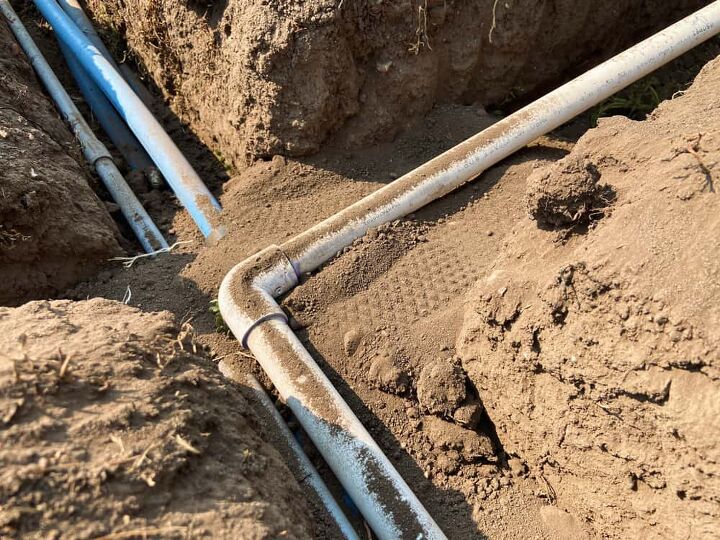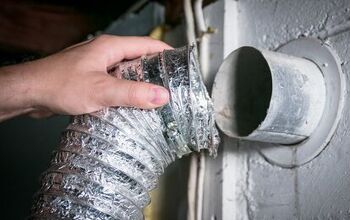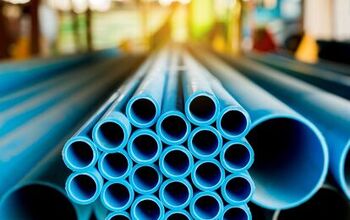Can You Drive Over Buried PVC Pipe? (Find Out Now!)

Getting the lay of the land is important whenever you move into a new home. Awareness of your surroundings will prevent you from making mistakes that could wind up being very damaging.
For instance, knowing where the pipes are buried in your yard is crucial. The exact placement of a particular pipe will play a huge role in how it stands up to potential damage. Knowing where the pipe is will tell you if you can drive over it.
Generally speaking, driving over buried pipe is acceptable if it’s positioned at the right depth and surrounded by the right soil. The pipe should be buried at least 12 inches into the ground, but going down to 24 inches is better. The soil should also be compacted in order to mitigate the weight the pipe is being asked to carry.
You must be careful before you start driving over your yard. One mistake could lead to busted pipes and a broken septic system. Find out more about the safety of driving over the PVC pipes in your yard by reading on.
5 Factors That Determine If You Can Drive Over Buried PVC Pipe
Whether or not you can drive over a PVC pipe buried in your yard will hinge on several factors. Let’s dive deeper into what those different factors are in the sections below.
The Arrangement of the Soil
First off, let’s focus on how the soil is arranged in your yard. How the soil is packed is what matters most here.
When a significant amount of weight is positioned over the PVC pipe, it reacts by flexing slightly. The pipe flexes along its sides in order to support the weight. Those sidewalls will stretch out and move down to keep the pipe intact.
PVC pipes can support a decent amount of weight, but they are still susceptible to breaking. They will need additional support especially if they’re being asked to bear the weight of a vehicle. That’s where the soil comes in.
If the soil is tightly packed, it can absorb some of the weight being placed on the PVC pipe. The soil acts like an additional solid surface that keeps the maximum amount of weight away from the pipes. You need stiff and packed soil if you want to protect the PVC pipes more effectively.
Loose soil simply will not offer much in terms of protection. It will not share the weight coming from above properly.
Make it a point to pack down the soil if you intend to drive your vehicle over your yard. Failing that, you can ask the previous owner of the property how the soil was handled so you can adjust accordingly.
The Type of Soil
Although the arrangement of the soil matters more, the type of soil you use still makes a difference. Some types of soil are better at supporting weight compared to others.
You want soil made from sedimentary rock in your backyard if at all possible. The bits of rocks in that type of soil are going to help out a lot. They will offset the amount of weight that would otherwise be directed right at the pipes.
Soil with gravel is another good option to consider here. You can also get away with using loam soil in your yard if you intend to drive over it. Clay is not as good as the aforementioned options. It would be best to limit your usage of that to growing plants in your yard.
How Deep the PVC Pipe Is Buried
Next up, we have to take a look at how deep the PVC pipe is buried. Simply put, you do not want the PVC pipe sticking out from the ground.
The depth of the pipe burial matters because that will affect how effectively the weight will be distributed. Keep the pipe too close to the surface and it will have to support too much weight. You’re not giving the surrounding soil enough of an opportunity to manage the burden.
When deciding how deep to position the PVC pipe, you should aim for at least 12 inches. You can go deeper than that if you want to protect the pipes further. Going deeper may even be necessary depending on the type of pipe you’re using. To err on the safe side, consider burying the pipes about 24 inches deep.
The Thickness of the PVC Pipe
You must know what kind of PVC pipe you have buried in your yard before driving your car over it. The thickness of the PVC pipe is what you really want to look at here.
To find out the thickness of the PVC pipe, you have to look at the schedule. A larger schedule number equates to a thicker PVC pipe, so schedule 40 is preferable to schedule 20. Do note though that you shouldn’t just automatically go with the thickest PVC pipes. The added thickness comes at the cost of the pipe opening becoming smaller.
If you’re looking for a sewage pipe, you want something that allows the waste to flow freely away from your home. Having a wide opening is still important.
Schedule 80 PVC pipes are great choices here. They are very thick and they are still open enough to keep your sewage system going. The only problem with schedule 80 PVC pipes is that they can be hard to find. They aren’t available everywhere so you may not be able to use them in your sewage system.
The good news is that schedule 40 PVC pipes work as suitable substitutes for their thicker counterparts. In contrast to the schedule 80 pipes, the schedule 40 variants are significantly easier to find.
The Age of the PVC Pipe
Aging will have an impact on how much weight a PVC pipe can bear. That’s due in large part to elements known as plasticizers.
Plasticizers are added to PVC pipes for the purposes of improving flexibility. Those plasticizers allow the pipe walls to bend whenever they are asked to bear weight. You want those plasticizers to remain in the PVC for as long as possible in order to maintain the pipe’s flexibility.
As you might have already guessed though, aging affects those plasticizers. The plasticizers escape from the PVC as the pipes continue to age.
The loss of the plasticizers won’t make much of a difference early on, but eventually, the pipe will become more rigid. That will only continue as the PVC pipe continues to age, which is why replacement is recommended.
Drive over an old PVC pipe and things can turn out badly. The pipe may split open at that point and spill out its contents, thus leading to a mess in your yard.
Other Factors to Consider
There are some additional considerations to keep in mind before you start driving around in your yard. They are related to the quality of the pipe as well as the soil you decide to use.
As noted above, soil featuring sedimentary rock is a great choice to use in your yard. The only real drawback to it is that the sharp edges of the rocks could damage the PVC pipes. You may want to add an extra layer of protection to keep the pipes from getting scratched.
Using sand is a good move here. Cover the area around the pipes with some sand to prevent the rocks from making direct contact. That way, you’re still benefiting from the support offered by the rocks without putting the pipe walls at risk.
You should also consider the condition the PVC pipes are in. If they have sustained prolonged damage, they will no longer be capable of supporting a lot of weight.
PVC pipes may sustain prolonged damage from the contents that flow through them. Chemical cleaners are known for damaging the interior of PVC pipes. Try to minimize your usage of those cleaners as much as possible.
Exposure to freezing temperatures can also be bad for PVC pipes. The freezing cold can cause the pipes to become more brittle. In that condition, they become more susceptible to external forces such as the weight of your vehicle.
Related Questions
How Long Can You Expect PVC Pipes to Last?
The problem with predicting how long PVC pipes will remain serviceable is that they simply haven’t been around for too long. Because of that, we still cannot be completely sure of how long they will hold up.Still, experts do suggest that PVC pipes should remain in working condition for about 100 years assuming proper installation and maintenance. You may not have to worry about replacing them anytime soon unless you moved into an older home.
Can You Drive over Other Parts of Your Septic System?
Driving over PVC pipes is fine in most situations, but that’s not the case for other elements of your septic system. The septic tank is especially susceptible to damage if you drive over it.Driving over the septic tank can deal significant damage to the septic tank’s lid. Even the tank itself is not guaranteed to be free from damage in that scenario.
Related Guides

Gary Evans is passionate about home improvement. He loves finding out how to make improvements in the easiest, most practical, and most affordable ways. Upgrading his home kitchen is one of his ongoing hobbies. Gary is also a long-time content creator and enjoys spending his free time tending to his hydroponic vegetable garden.
More by Gary Evans
















![12 Washing Machine Brands to Avoid [with Recall Data]](https://cdn-fastly.upgradedhome.com/media/2023/07/31/9075781/12-washing-machine-brands-to-avoid-with-recall-data.jpg?size=350x220)










